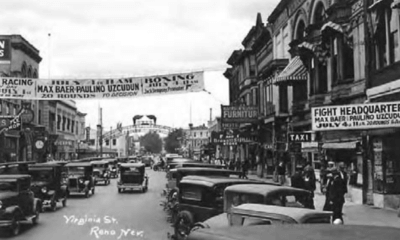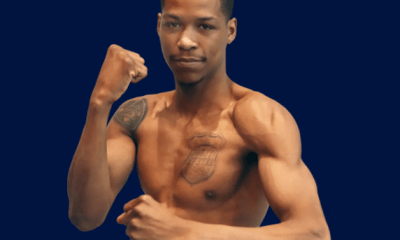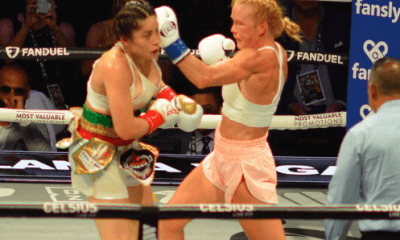Featured Articles
Jim Lampley and 16 Others Weigh in on the Problem of PED Use in Boxing
For this latest survey, I reached out for suggestions from our regular panel of respondents. Among the fascinating survey questions submitted

For this latest survey, I reached out for suggestions from our regular panel of respondents. Among the fascinating survey questions submitted were “Should Boxers Be Allowed to Have Beards?” and “What Was Your Brush With Greatness?”
Picking one was difficult, but I ultimately chose to go with a question of great topical interest: How Would You Deal With PED Cheats? Thanks to Steve Canton for passing along this suggestion. A Floridian, Steve has been involved in every aspect of boxing for more than 50 years. Once again, the respondents are listed alphabetically.
MATT ANDRZEJEWSKI (TSS boxing writer): I am an advocate of three strikes and you’re out. A first positive test would be a one-year ban from all ratings (and/or stripped of belt) and to re-enter the ratings the fighter would have to defeat a top ten opponent. The second offense would be an 18-month ban from ratings (and/or stripped of belt) and to re-renter ratings the boxer would have to defeat a top ten opponent. And a third positive test is permanent ban from ratings.
JOE BRUNO (former NYC sportswriter and author of more than 45 crime-related books): First offense – one-year suspension. Second offense – three year suspension. Third offense – lifetime ban. No appeal processes. Of course, this being America, the suspended fighter can sue. Good luck with that
STEVE CANTON (author and the face of boxing in Florida): My opinion: Anyone who fails a PED test should be banned for life from boxing, no questions asked. Career is over – permanently. The problem would disappear in a hurry. (Note: Steve also favors stiff penalties for those who come in overweight.)
MONTE COX (boxing historian): I’m not sure how much PEDs help a boxer, but I definitely feel it is cheating. Unfortunately, it’s so hard to regulate that maybe they should let everyone use to guarantee a level playing field. That’s sad to say though.
BERNARD FERNANDEZ (journalist; one of only eight lifetime members of the Boxing Writers Association of America): Some drug tests, although rare, yield false positives. That is why I think it might be excessive to institute a one-strike-and-you’re-out-forever policy. There is also a difference between the type of designer drugs that turned baseball’s Barry Bonds from a 185-pound leadoff-man type into a 235-pound home run machine, and trace amounts of a banned substance found in certain legitimate medications. A first offense should result in a one-year suspension and a fine, not necessarily a career-killer, and a second a four-year suspension with a stiffer fine. A third offense? Permanent banishment and a major hit to the bank account. Oh, and let’s convince the International Boxing Hall of Fame to forever ban two- or three-time offenders.
LEE GROVES (author, writer and the Wizard of CompuBox): It would be easy to throw the hammer down and impose an instant and permanent ban upon hearing the accusation because it is true that boxing is a tough enough sport without throwing chemically enhanced fighters (and chemically enhanced punches) into the mix. The effects of PEDs, particularly in boxing, are deadlier than in most other sports because there are bodies, brains and long-term quality of life issues involved. Therefore, PED cases must be dealt with severely when confirmed, not only as a punishment for the offenders but also to act as a deterrent for those thinking about juicing. Because a PED conviction can stain a fighter’s reputation — and money-making ability — for the rest of his life, accusations should be approached with the utmost care and due process should be exercised, which I believe it is.
If a fighter is exonerated, that exoneration should be trumpeted as loudly and as widely as the original accusation so that the damage can be reversed as much as possible. After all, fair is fair. With the current scheduling protocol between fights — superstars fight only twice a year if that — the penalty should also be long enough to inflict deep pain. I believe the minimum penalty for a first offense should be two years, and I wouldn’t mind if it was three. A second offense should result in a lifetime ban as well as an especially punitive fine. If such athletes were to try other sports (such as MMA or kickboxing) in order to skirt around the first-offense penalty, that PED penalty should follow them and disqualify them as well. To sum up, PEDs are a real issue and while protocols should be followed, the penalties for the guilty should be severe and long-lasting.
HENRY HASCUP (historian, collector, and long-time president of the New Jersey Boxing Hall of Fame): I’d fine and suspend them and take any relevant title away.
JEFF JOWETT (longtime boxing scribe and heir to the late Jack Obermayer as an authority on Diners): I don’t have much of an opinion. I’m not in the administrative end of the sport much. I do see one problem, though, in invalidating fight results. I don’t believe anyone can effectively determine what role a PED actually played in the outcome of a contest. Suppose the guy got knocked out? Then take the victory away from the opponent and call it NC? Or suppose the offender won! Is it right to say he won BECAUSE of the PED? A pretty devilish situation. As to what to do about it, I guess the only response would be increasing lengths of suspensions. If he’s not allowed to box, he can’t make $$$. That would seem a deterrent enough.
DR. STUART KIRSCHENBAUM (Michigan State Boxing Commissioner Emeritus and advisor to the governor on boxing issues): As a former State Boxing Commissioner and Co-Founder of The Association of Boxing Commissions, I was an early pioneer in the testing of drugs in boxers. At the onset of testing, approximately 70 per cent of those tested were positive …mostly of the street environmental culture kind of cocaine, amphetamines, cannabis, morphine, heroin. These were taken not for performance enhancement but rather recreational use. For the most part, these drugs were PNED…Performance Non-Enhancement Drugs. However, they were illegal and in an effort to clean up the negativity of the sport, boxers were punished with suspensions and still are. I hate to say but looking back boxers and trainers were not sophisticated to even think of any pharmacological advantage of other PEDS available as are used in other sports.
JIM LAMPLEY (IBHOF inductee and long-time anchor of HBO broadcasting team): Point one is that this is way too simplistic a question for the breadth and complexity of the subject. I could write for days. Point two is I favor the application of VADA testing in every fight in every venue in every jurisdiction in the world. But I don’t have the authority to mandate that, no one does, and we would be required to manufacture dozens more Margaret Goodman’s, and it can’t be done. Point three is even if we did that testing, all our past experience with sordid street drugs, sophisticated pharmaceutical recreation, and PEDs should be sufficient by now to establish we will NEVER significantly diminish their use, much less end it, via punishment and penalty. The drugs and their effects are too strong for that to happen. Now the most important point: For fifty years now, the development of the PED story has always wrapped itself around the suspected glamour user of the moment: Marian Jones, Mark McGwire, Lance Armstrong, Barry Bonds. Never is enough attention paid to the sources of the supply, the global pipeline, the massive profit motive, and the degree to which all the inner chambers of most sports have been penetrated. The history of PEDs is mostly codified episodically, so fans look past the discussion and accept what they are watching. It grows and grows and globally.
So, what do I do with PED users? Give them a league of their own? Fact is, many PED users are athletes whose perceived accomplishments have earned them audiences and people are still going to want to watch them perform. But the vital question is not what to do with them, but rather what to do with the damage they do to standards of competition. As usual, the real answers lie in all the things society finds too expensive, cumbersome and time-consuming to do: childhood education, extension of morality for morality’s sake, broad-based examination of the ecosystem that produces these behaviors, the provision and promotion of real opportunities and advantages for those who do things the right way. We keep looking for the quick fix. There is no quick fix.
“The worst thing possible hasn’t happened yet.”—Jim Lampley
************************************
RON LIPTON (world class boxing referee, former fighter, boxing historian, retired police officer): Once revealed and the report confirmed, their scheduled bout would be cancelled. A hearing would ensue and if the evidence merits it, a suspension would follow. Upon an application to return to the ring, a clean bill of health under the most reputable scrutiny would be mandated.
ADEYINKA MAKINDE (author, boxing writer and UK Barrister): It should be treated quite severely relative to other sports. It is one thing to take drugs to run faster than another human being but quite another when it gives an athlete an advantage in regard to strength and endurance when participating in a combat sport. Bearing this mind, a suggested five-year ban or even a life-time ban should not appear draconian. Admittedly, such a policy needs to be predicated on a watertight, evenly applied regime of testing. The defense of contaminated supplements is one that has plausibility but is at the same time one that is clearly rife with abuse. Also, as the recent positive test of Canelo Alvarez demonstrates, double-standards abound. The universal application of USADA-style all-year-round testing as applied in the UFC would be a step in the right direction for boxing.
PAUL MAGNO (author, writer and Mexican boxing official): I suspect that many, many people in boxing don’t want to really know who is dirty and who isn’t. If we got a real testing program going, lots of money would be lost by lots of boxing big shots. If boxing is serious about monitoring for PEDs, however, they need universal, 24-7/365 random testing and some sort of commission in place to actually uphold clear and consistent punishment for offenses. Obviously, in the here and now, PEDs cheats should face some sort of suspension and fine. But it’s all meaningless unless these dirty fighters are actually held accountable for their actions– and that’s just not the case right now. State commissions should step up and do the heavy lifting in this regard. Then again, if commission PEDs testing is spotty and useless and fighter/promoter-directed voluntary testing is less than 100% reliable, how can we really punish ANYONE? The system is broken here and, I suspect, conveniently so.
LARRY MERCHANT (legendary retired member of the HBO broadcasting team): Prizefighting is largely about risk and reward. Whatever the reward of using PEDs — and Dr. Margaret Goodman once told me that not a single fighter she knew who tested positive had leaped forward in punching power or class — there should be heightened risk. Baseball has it about right: half a season (half a year in boxing) for the first test failure, a full season (year) for the second, banishment for a third. Failure a second or third time, anyway, suggests a degree of knuckle-headedness that even regular knuckleheads can’t imagine. The guy needs help of another kind.
******************************************************
“ We need more guys…willing to voluntarily submit to the most rigorous drug-protocols. And those who don’t and get nailed need to find out it wasn’t worth the risk. I’m not sure boxing commissions have stepped up to that responsibility yet.”—Larry Merchant
“I mean, this is a physical sport and you can get hurt and end up dead…”—Carlos Molina
ERNESTO MORALES (former boxer and boxing writer): During my involvement in the game over the years I’ve personally known a few cheats, a small few, both pros and amateurs. Some willfully have chosen to take the risk of cheating but not all. Some we’re induced/convinced or fallen victim to the exhortations of their trainers, with their managers also having FULL knowledge, to the point to where they themselves were shelling out the $$$ for this disgraceful crime. This is one side that is NEVER considered nor ever mentioned when fighters test positive. Did Margarito cheat by himself? Of course not!
Now what should be done? It all depends. If he is a champ he should be dealt with tough justice. HEAVY fines and EFFECTIVE suspensions, BOTH. He has no excuse and chances are his stain on the game has a more negative effect, first offender or not. Other offenders should also be punished with fines/suspensions or both. The examples have to be set and the lines drawn. Sadly, the trainers who are in on it will never get sanctioned. Now, most trainers do NOT condone this dirt BUT it is true that a very small few actually do. It pains me say that.
TED SARES (TSS boxing writer): Six months; 18 months; life-time ban. Three strikes and you’re out. I also agree with Paul Magno that the system is broken at the state level with too many political hacks//appointees on commissions. Also, three-time offenders should never be inducted into the IBHOF. One of my favorite quotes comes from former Bad Left Hook colleague Brent Brookhouse: “…it’s not testing from an agency like VADA that is flawed; it’s the sport of boxing from the bottom up. It’s on the promoters and the fighters. It’s on the commissions. It’s on the networks who don’t demand better. It’s on the media, all too happy to play nice and get their generic five minute ‘exclusive interviews’ rather than rock the boat. And, it’s on fans who don’t say that they’re sick of the transparent garbage from everyone in the game.” SAD.
ICEMAN JOHN SCULLY (former world light heavyweight title challenger, trainer, commentator): If it is proven beyond the shadow of a doubt that a person willingly took a performance-enhancing drug then I have no problem with him being banned for life. You let it be known well in advance that this is the penalty and let the chips fall where they may. Now I understand that sometimes people can take things without knowing it, so it’s a slippery slope, but if it could be proven that the person took something willingly, a lifetime ban is no problem with me
Observations and Comments:
I invited several boxers to participate and they declined. That’s understandable. If weight lifters were asked the same question, they too might not want to respond. That being said, Jim Lampley’s response was one that hit on all cylinders.
There was a consensus that boxing commissions were remiss by not stepping up to the plate. Some (me included) suggested the system is broken. Also, there was a consensus that the penalties should be stiff as the distinction between boxing and other sports was made clear.
In the end, just about every abuser has a lame excuse—contaminated meat is the go-to excuse these days– and just about every abuser returns to fight another day. But clearly, the cumulative evidence of PED use has become troubling.
Ted Sares is one of the oldest full power lifters (and Strongman competitors) in the world and is a four-time winner of the EPF’s Grand Master championship. He also is a member of Ring 4’s Boxing Hall of Fame.
Check out more boxing news on video at The Boxing Channel
-

 Featured Articles3 weeks ago
Featured Articles3 weeks agoAvila Perspective, Chap. 330: Matchroom in New York plus the Latest on Canelo-Crawford
-

 Featured Articles2 weeks ago
Featured Articles2 weeks agoVito Mielnicki Jr Whitewashes Kamil Gardzielik Before the Home Folks in Newark
-

 Featured Articles4 weeks ago
Featured Articles4 weeks agoOpetaia and Nakatani Crush Overmatched Foes, Capping Off a Wild Boxing Weekend
-

 Featured Articles4 weeks ago
Featured Articles4 weeks agoAvila Perspective, Chap 329: Pacquiao is Back, Fabio in England and More
-

 Featured Articles3 weeks ago
Featured Articles3 weeks agoCatching Up with Clay Moyle Who Talks About His Massive Collection of Boxing Books
-

 Featured Articles4 weeks ago
Featured Articles4 weeks agoFabio Wardley Comes from Behind to KO Justis Huni
-

 Featured Articles2 weeks ago
Featured Articles2 weeks agoMore Medals for Hawaii’s Patricio Family at the USA Boxing Summer Festival
-

 Featured Articles3 weeks ago
Featured Articles3 weeks agoThe Shafting of Blair “The Flair” Cobbs, a Familiar Thread in the Cruelest Sport






















